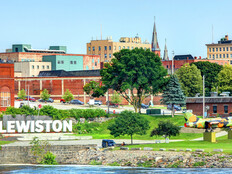Smart Cities Of The Future
Municipalities put a variety of cutting-edge technologies to use to improve the lives of citizens.
.jpg)
Ryan Etter
Gunshot Detection
Public safety departments can call on gunshot detection systems to combat gun violence. Acoustic surveillance devices comprising microphones and sound analysis hardware detect and triangulate weapons fire. These sophisticated tools pinpoint the location of weapons fire, whether the shooter is stationary or mobile, the number of shots fired and even the type of gun.
Some of the cities that have implemented gunshot detection systems include Baton Rouge, La.; Beloit, Wis.; Chicago; Compton, Calif.; East Palo Alto, Calif.; Harrisburg, Pa.; Memphis, Tenn.; Newark, N.J.; Paterson, N.J.; Roosevelt, N.Y.; San Francisco; and Uniondale, N.Y.
Automatic License Plate Readers (ALPRs)
First developed to deter terrorist attacks in the U.K., automatic license plate readers now help law enforcement search for stolen vehicles or vehicles associated with AMBER Alerts, felony warrants and unpaid parking tickets. Infrared cameras mounted on police cars read license plates, check them against a database of wanted plates and notify officers when there’s a match.
Communities such as Cincinnati, Houston, Los Angeles County and San Jose, Calif., tap ALPR technology.
Automatic Vehicle Location (AVL)
Global Positioning Systems (GPS)
Cities boost efficiency and improve safety by using automatic vehicle location technology to track the location of public transportation, emergency or maintenance vehicles equipped with global positioning systems. For example, sanitation drivers in Clemson, S.C., use a GPS tool on a PDA to note the location of large items such as old appliances or sofas that special garbage trucks need to pick up.
Radio Frequency Identification (RFID)
RFID technology tracks recycling rates through communities such as Cranberry Township, Pa.; Howard County, Md.; and Pleasant Prairie, Wis. Trash trucks outfitted with RFID readers capture data from RFID tags placed on the lids of recycling containers.
Other state and local government applications for the technology include tracking of inmates, evacuees, voting equipment, luggage, case files, criminal evidence and library resources.
Surveillance Systems
Scores of cities have rolled out surveillance cameras to deter crime and help catch criminals. Look around and you’ll find cameras deployed downtown, in public areas, on traffic lights and aboard public transit vehicles, among other places.
Intelligent Transportation Systems
The Intelligent Transportation Society of America advocates for intelligent transportation solutions ranging from advanced traveler information, electronic tolling, traffic light synchronization, signal prioritization, and vehicle-to-vehicle and vehicle-to-roadside communication to prevent accidents.
Wireless Sensors
San Francisco is testing wireless sensors that alert drivers to unoccupied metered parking spaces. Sensors glued to the pavement funnel data to a centralized management system. The data can be displayed on street signs and websites that drivers can access through smartphones, directing them to available parking and reducing pollution caused by trolling for a spot.
For more ways government uses wireless sensors, click here.








